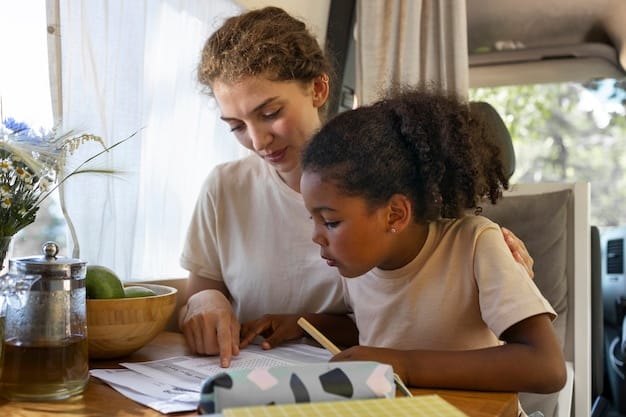Maximize Your Impact: School Zone Volunteer Programs in Your Community

School Zone Volunteer Programs: How You Can Make a Difference in Your Local Community offer numerous ways to contribute, from ensuring student safety as crossing guards to enhancing educational experiences through tutoring, mentoring, and classroom assistance.
Looking for a meaningful way to give back to your community? School Zone Volunteer Programs: How You Can Make a Difference in Your Local Community offer a fantastic opportunity to support students, teachers, and families, creating safer and more enriching learning environments. From helping children cross the street to assisting in the classroom, your contribution can have a lasting impact.
Understanding School Zone Volunteer Programs
School zone volunteer programs are initiatives designed to enhance the safety, educational environment, and overall well-being of students within designated school zones. These programs rely on the dedication and support of community members who volunteer their time and skills to assist schools in various capacities.
These programs not only benefit the students and the school but also provide volunteers with a sense of purpose and community involvement. By understanding the scope and importance of these programs, more people can be encouraged to participate and contribute to their local schools.
Key Objectives of School Zone Programs
School zone volunteer programs aim to address several critical needs within the school environment. Here are some primary objectives:
- Enhancing Student Safety: Volunteers help ensure students’ safety during arrival and dismissal times, particularly in high-traffic areas.
- Supporting Educational Activities: Volunteers assist teachers and staff with classroom activities, tutoring, and other educational support.
- Promoting Community Engagement: These programs foster a stronger connection between the school and the local community, encouraging greater participation and investment.
- Providing Mentorship and Guidance: Volunteers serve as positive role models and mentors for students, offering guidance and support.

Benefits of Volunteering
Volunteering in school zone programs offers numerous advantages for both the school and the volunteers themselves. Here are some key benefits:
- Improved Student Outcomes: With additional support, students often experience improved academic performance and increased confidence.
- Enhanced School Environment: Volunteers contribute to a more positive and supportive school atmosphere.
- Personal Fulfillment: Volunteering provides individuals with a sense of purpose, satisfaction, and connection to their community.
In conclusion, school zone volunteer programs are essential for creating safer, more supportive, and engaging learning environments. These programs rely on the active participation of community members who are willing to dedicate their time and skills to make a difference in the lives of students and the overall well-being of the school.
The Role of Crossing Guards
One of the most critical roles in school zone volunteer programs is that of the crossing guard. Crossing guards play a vital part in ensuring the safety of students as they walk to and from school, especially across busy streets and intersections.
These dedicated individuals help manage traffic flow and provide a safe passage for children, significantly reducing the risk of accidents. Understanding the importance and responsibilities of crossing guards can highlight how impactful this specific volunteer role can be.
Responsibilities of Crossing Guards
Crossing guards have several key responsibilities to ensure student safety. These include:
- Monitoring Traffic: Crossing guards observe traffic patterns and wait for safe gaps before allowing students to cross.
- Using Signals: They use stop signs and hand signals to direct traffic and ensure vehicles come to a complete stop.
- Guiding Students: Crossing guards guide students across the street, ensuring they walk within designated crosswalks and obey traffic signals.
Crossing guards also play a role in educating students about pedestrian safety. They remind children to look both ways before crossing and to be aware of their surroundings at all times.
Training and Qualifications
To effectively perform their duties, crossing guards typically undergo specific training. This training covers various aspects of traffic management and pedestrian safety, including:
- Traffic Laws: Understanding local traffic laws and regulations related to pedestrian safety.
- Emergency Procedures: Knowing how to respond in case of an accident or other emergency situations.
- Communication Skills: Being able to effectively communicate with both drivers and students.
In summary, the role of crossing guards in school zone volunteer programs is indispensable. These volunteers play a critical part in ensuring the safety of students as they travel to and from school.
Classroom Assistance and Tutoring
Beyond ensuring physical safety, school zone volunteer programs often involve providing essential support within the classroom. This can include assisting teachers with administrative tasks, helping students with their studies, and tutoring in specific subjects.
Volunteers who offer classroom assistance and tutoring play a crucial role in enhancing the educational experience for students and reducing the workload for teachers. Their involvement can significantly improve student outcomes and create a more supportive learning environment.
Supporting Teachers
Teachers often face numerous challenges, including large class sizes and limited resources. Volunteers can provide invaluable assistance by:
- Preparing Materials: Helping to prepare lesson plans, worksheets, and other instructional materials.
- Organizing the Classroom: Assisting with organizing and maintaining the classroom environment.
- Managing Administrative Tasks: Taking on administrative tasks such as grading papers and tracking attendance.
Tutoring and Mentoring Students
Volunteers can also support students directly by offering tutoring and mentoring. This can involve:
- One-on-One Tutoring: Providing individualized instruction to students who need extra help in specific subjects.
- Small Group Tutoring: Working with small groups of students to reinforce concepts and skills.
- Mentoring: Serving as a positive role model and mentor for students, offering guidance and support.

Volunteers who provide classroom assistance and tutoring are essential for creating a more supportive and enriching learning environment. By offering their time and skills, they contribute to the academic success and overall well-being of students.
Mentoring and Role Modeling
Mentoring and role modeling are vital components of school zone volunteer programs. Volunteers who serve as mentors offer guidance, support, and encouragement to students, helping them navigate academic and personal challenges.
These relationships can have a profound impact on students’ lives, fostering positive self-esteem, improving academic outcomes, and inspiring them to pursue their goals. Understanding the benefits and methods of effective mentoring can encourage more individuals to volunteer in this capacity.
Benefits of Mentoring
The benefits of mentoring for students are numerous and far-reaching. These include:
- Improved Academic Performance: Mentors can help students improve their study habits, time management skills, and overall academic performance.
- Increased Self-Esteem: Positive relationships with mentors can boost students’ self-esteem and confidence.
- Guidance and Support: Mentors provide a safe space for students to discuss their challenges and receive guidance and support.
Qualities of Effective Mentors
Effective mentors possess certain qualities that enable them to build strong and positive relationships with students. These include:
- Patience and Empathy: The ability to listen to students’ concerns and provide support without judgment.
- Positive Role Modeling: Demonstrating positive behaviors and attitudes that students can emulate.
- Effective Communication: The ability to communicate clearly and effectively with students, parents, and school staff.
In conclusion, mentoring and role modeling are essential aspects of school zone volunteer programs. These volunteers provide invaluable support and guidance to students, helping them succeed academically and personally.
Community Engagement and Partnerships
Successful school zone volunteer programs often rely on strong community engagement and partnerships. When schools collaborate with local organizations, businesses, and community groups, they can create a more comprehensive and supportive environment for students.
Community engagement and partnerships ensure that schools have access to a wide range of resources and volunteers. This collaborative approach fosters a sense of shared responsibility for the well-being and success of students.
Building Partnerships
Schools can build partnerships with various community organizations to enhance their volunteer programs. Some potential partners include:
- Local Businesses: Businesses can provide financial support, volunteer hours, and mentorship opportunities.
- Community Centers: Community centers can serve as a hub for volunteer recruitment and training.
- Nonprofit Organizations: Nonprofits often have expertise in specific areas, such as tutoring or mentoring, and can provide valuable resources.
Engaging Parents and Families
Parental involvement is crucial for the success of any school program. Schools can engage parents and families by:
- Hosting Volunteer Events: Organizing events where parents can volunteer their time and skills.
- Communicating Regularly: Keeping parents informed about volunteer opportunities and school initiatives.
- Seeking Input: Soliciting feedback from parents on how to improve school programs.
To summarize, community engagement and partnerships are vital for creating comprehensive and sustainable school zone volunteer programs. By collaborating with local organizations, businesses, and families, schools can ensure that students have access to the resources and support they need to succeed.
Getting Involved: How to Volunteer
If you’re interested in making a difference in your local community, volunteering in a school zone program is a great way to do it. Getting involved is often a straightforward process, and your contribution can have a significant impact on the lives of students and the overall school environment.
Whether you have a few hours a week or more time to dedicate, there are numerous ways to get involved and support your local school. Understanding the steps to become a volunteer and the various roles available can help you find the perfect fit for your skills and interests.
Steps to Become a Volunteer
The process of becoming a school zone volunteer typically involves several steps:
- Contact the School: Reach out to the local school or school district to inquire about volunteer opportunities.
- Complete an Application: Fill out a volunteer application, providing information about your background, skills, and availability.
- Background Check: Undergo a background check to ensure the safety and well-being of students.
- Attend Training: Participate in any required training sessions to learn about your role and responsibilities.
Types of Volunteer Opportunities
School zone volunteer programs offer a variety of opportunities to suit different interests and schedules. These include:
- Crossing Guard: Helping students safely cross the street before and after school.
- Classroom Assistant: Assisting teachers with administrative tasks, preparing materials, and tutoring students.
- Mentor: Providing guidance and support to students through one-on-one mentoring relationships.
In conclusion, getting involved in school zone volunteer programs is a rewarding and impactful way to contribute to your community. By following the steps to become a volunteer and exploring the various opportunities available, you can find a role that aligns with your skills and interests.
| Key Area | Brief Description |
|---|---|
| 🚶♀️ Crossing Guard | Ensures student safety at school entrances and crossings. |
| 📚 Classroom Aid | Supports teachers with tasks like prep and tutoring. |
| 🤝 Mentor | Provides guidance and support to students, boosting confidence. |
| 📢 Community Liaison | Connects the school with local resources and support systems. |
Frequently Asked Questions
It is a structured initiative where community members volunteer at schools, assisting with safety, education, and student support, enhancing the school’s overall environment.
Begin by contacting your local school district or the specific school you’re interested in to learn about their volunteer process and requirements.
Each program varies; some roles might require specific skills or have age restrictions, but many opportunities are open to a wide range of volunteers.
Volunteering provides personal satisfaction, community engagement, and the opportunity to positively impact students and the educational environment directly.
Schools typically offer training, guidelines, and ongoing support to ensure volunteers are well-prepared and comfortable in their roles, maximizing their effectiveness.
Conclusion
In conclusion, school zone volunteer programs: how you can make a difference in your local community, are invaluable resources that enhance student safety, academic support, and community engagement. By offering your time and skills, you can contribute to creating a more enriching and secure learning environment for students and foster stronger connections between schools and the broader community, making a lasting impact on the lives of young learners.





